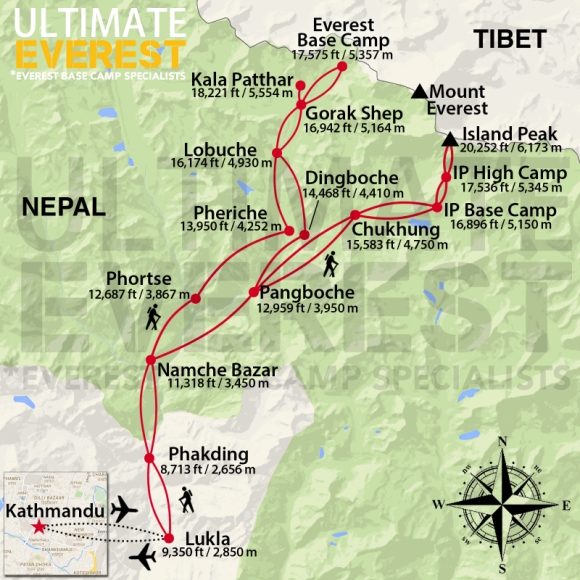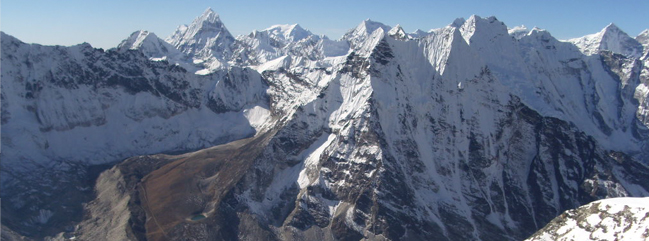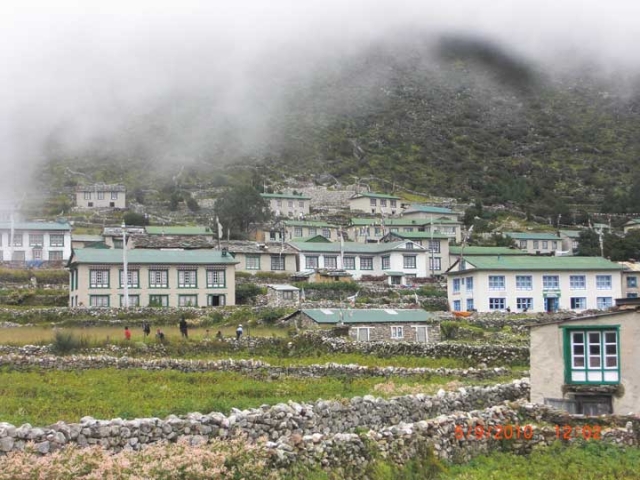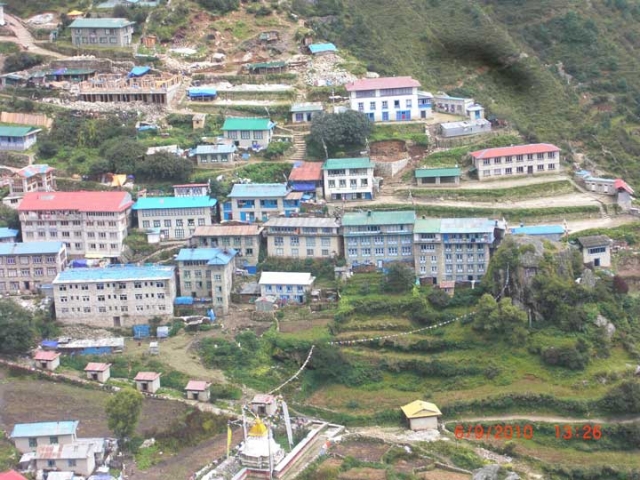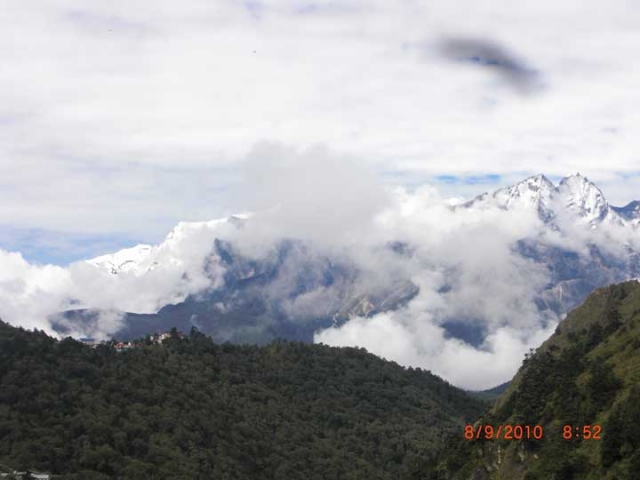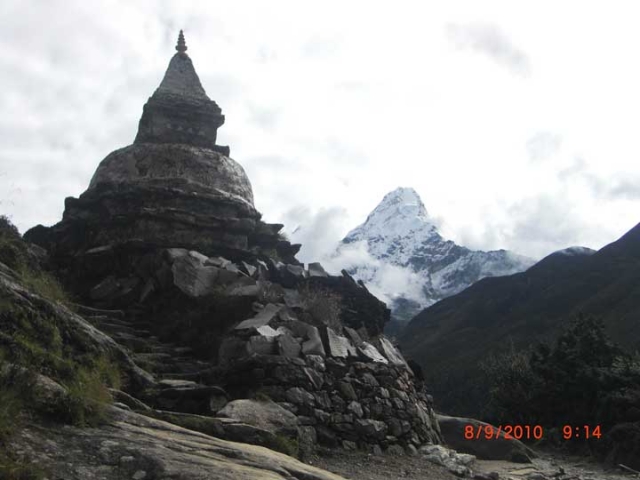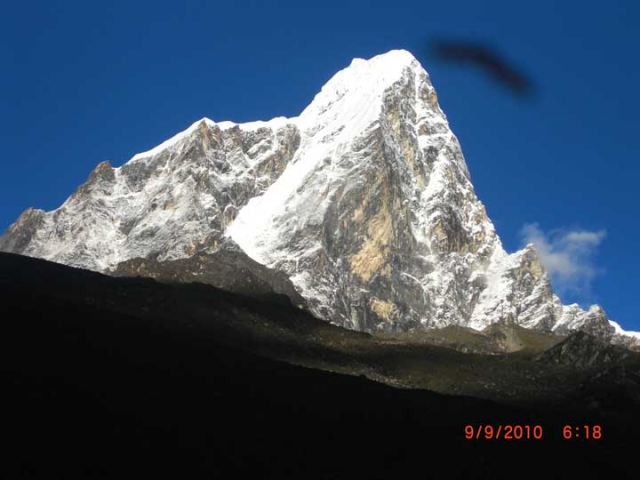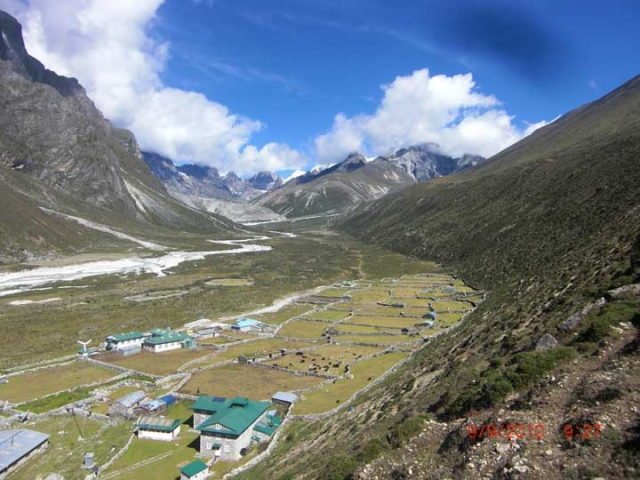This professionally designed Island peak climbing itinerary takes you to the acclimatization hike to the most popular trekking destination of Everest Base Camp and Kala Pattar first for the close up views of Mt. Everest before scaling the pick. Island Peak was the name given to the mountain in 1952 by Eric Shipton’s who thought it to be reminiscent of an island in a sea of ice. It is also known as “Imja Tse” in Sherpa Name.
After exploring the temples, shrines, bazaars and restaurants of Kathmandu we take an exciting mountain flight to Lukla and trek up the Dudh Kosi Valley, surrounded by the soaring peaks of Thamserku and Kusum Kanguru. It’s a steep ascent to Namche Bazaar, capital of the Kumbu Sherpas, where we are again greeted by spectacular mountain vistas. A rest day here aids acclimatization and there are great optional walks to enjoy the area.
We continue trek to Tengboche Pheriche and accommodate at high altitude in Gorekshep. After enjoying with magnificent views of Mt Everest and surrounding peaks, we continue descend to Chhukung to prepare for the ascent of Island Peak. After a day of walking from Chhukung we reach the Island Peak Base Camp to prepare for to attempt the peak. It may take an additional day or two to scale the peak depending on weather conditions. For some people reaching to the summit from the base camp is a day activity. However, some climbers prefer alpine style camping at high camp which adds the joy of climbing and also helps a safe ascent. After a successful climbing we return at our leisurely pace back to Namche and Lukla for our return flight to Kathmandu.
Day 01- Arrival in Kathmandu airport (1345meters).
There you will be met by our Airport Representative and transferred to hotel by private tourist vehicle. Overnight at hotel.
Day 02- Pre-trip Meeting and Sightseeing around Kathmandu Valley.
In the morning after breakfast at 9 AM, we host a Pre-Trip meeting at your hotel in Kathmandu and introduced your trek Leader/Guide mean time and it will provide an opportunity for individuals to ask questions about the your trek and to introduce you to other participants. This includes a final briefing and preparations for the trip.
PLEASE ADVISE US IF YOU WILL BE ARRIVING LATE AND ARE THEREFORE UNABLE TO ATTEND THE PRE-TRIP MEETING.
In THE PRE-TRIP MEETING All passengers MUST bring:
1. Passport.
2. Four copies of Passport size photos each.
3. Travel Insurance Policy.
4. A writing pen
5. Notepad.
After the Pre-Trip meeting and breakfast your sightseeing trip will start at 9.45 AM in the morning. We provide a private vehicle and professional tour guide. We visit Bodhnath Stupa, one of the biggest Buddhist shrines in the world, where we observe Buddhist monks in prayer in the monasteries surrounding the stupa. After Bodhnath Stupa we visit Pashupatinath, the most famous Hindu temple in the country, located on the banks of the holy Bagmati River. Here we see Hindu holy men (sadhus) meditating, pilgrims bathing and occasionally funeral pyres burning on the ghats. We also visit Bhaktapur Durbar Square, which is a collection of pagoda and shikhara – style temples grouped around a fifty-five-window palace of brick and wood. The attraction of the Bhaktapur Durbar Square is The Lion gate, The Golden gate, The Palace of fifty five windows, Art Galleries, The Statue of King Bhupatindra Malla.
The rest of our time in Kathmandu is free for further exploration and some last-minute shopping in Thamel area near by your hotel. Later, we are supplied with our Trek Pack and departure information for tomorrow. Overnight at hotel.
Day 03- Fly to Lukla (2804 meters) trek to Phakding (2610 meters) 3 hours.
An early morning start takes us to Tribhuwan international Airport in Kathmandu for the 35 minute scenic flight to Tenzing and Hillary Airport at Lukla at 2804meters. On arrival at the airport guide will brief you and introduce our porters before we begin our trek towards Phakding at 2610meters.
After landing we have time to explore the village while our Sherpa crew sort and load our trekking equipment. Then we begin our trek by descending towards the Dudh Kosi River where we join the main trail to Namche Bazaar, located just above Chaunrikharka (2713m). The walking is easy and after passing through the small village of Ghat (2550m) it is a short walk to Phakding. Overnight at Guesthouse.
Day 04- Trek to Namche Bazaar (3441 meters) 5.30 hours.
We continue trekking along the banks of the Dudh Kosi, crossing this majestic river many times on exciting suspension bridges laden with prayer flags. After entering Sagamartha National Park, the trail climbs steeply with breathtaking views. Namche Bazaar known as the Gateway to Everest which is home to many quality restaurants, hotels, lodges, shops, Money exchange, internet cafe and a bakery. Namche is one of the biggest villages along the whole Everest trail. Overnight at Guesthouse.
Day 05- Namche Bazaar Acclimatization day.
We will spend a day here in order to acclimatize and adjust to the thinning of the air. As well as a short trek to a museum celebrating the traditional customs of the Sherpa people to visit. Today we hike up the Syangboche Airport, and around Everest View Hotel. From this point, we can see rewarding views of the Himalayas with a stunning sunrise or sunset over the panorama of the Khumbu peaks. Overnight at Guesthouse.
Day 06- Trek to Tengboche Monastery (3860 meters) 5 hours.
The trek continues along the rushing glacial waters of the Dudh Kosi with magnificent views of the mountains. We trek to an altitude of 3860meters today. On reaching Tengboche you will see the local monastery. Inside the monastery are incredibly ornate wall hangings, a 20-foot sculpture of Buddha, and the musical instruments and robes of the Lamas. The group will be taken to observe a prayer ceremony either in the evening or morning depending on how the days trekking went. Overnight at Guesthouse.
Day 07- Trek to Pheriche (4200 meters) 5.30 hours.
We descend for half an hour to river side through nice forest,, cross the river and start trekking up towards opposite hill and landscapes starts more dry and desert afterwards. We will cross a traditional and cultural sherpa village Panboche where we can see a close up daily activities of sherpa people. After this, we make a gradual up towards a small hill afterwards trail goes to wide mountain valley called pheriche. This is a nice wide village located on the riverside. A small helipad is available here for helicopter rescue and daily High altitude Mountain sickness class available here with Mt. Specialist. Overnight at Guesthouse.
Day 08- Rest and acclimatization day.
Today you can enjoy another day for acclimatization. We will have trip to Dingboche Ri to get a marvelous view of the surrounding mountains, especially Lhotse’s massive south wall, then return to Dingboche in the evening. Overnight at Guesthouse.
Day 09- Trek to Lobuche (4910 meters) 5 hours.
Today, the trail continues along the lateral moraine of the Khumbu Glacier and passes by stone memorials for climbers who have perished on nearby summits. We continue to climb as we are heading to the altitude of 4910 meters at Lobuche which is really just a few huts at the foot of giant Lobuche peak. Some breathing problems may arise today due to the altitude. Overnight at Guesthouse.
Day 10- Trek to Gorak Shep (5180 meters) then hike up to Kalapattar (5555 meters) back to Gorak Shep. 7 hours.
This will be one of the most difficult yet rewarding days of the trek. Most of this day is spent climbing Mt. Kala Patar, a small peak (by Himalayan standards) at 5555meters. The ascent is demanding but the climber gets the most magnificent mountain panorama possible: Everest, the highest point on the planet at 29028ft, 8848meters, towers directly ahead and on all sides loom the other giants, Nuptse, Pumori, Chagatse, Lhotse and countless others. If possible we can stay and watch the awe-inspiring sunset on Everest and its neighbours. We make a quick descent to Gorak Shep, a tiny hamlet at 5180 meters. Overnight at Guesthouse.
Day 11- Trek to Everest Base Camp (5365 meters) then back to Lobuche (4910 meters). 7 hours.
This is another big day walk along the Khumbu Glacier and up to Everest Base Camp at 5365meters. , the closest you can get to Mt. Everest without mountaineering equipment. There will likely be a team there about to attempt the summit. The view of the Khumbu Icefall from Base Camp is spectacular. We return down to Lobuche for the night. Overnight at Guesthouse.
Day 12- Trek to Chukkung (4710 meters), 6 hours.
From Lobuche we take a slightly different route down to Dingboche. Then we slightly ascend into the Chukkung Valley. Overnight at Guesthouse.
Day 13- Trek to Island peak base camp (5240 meters) 4 hours.
From Chukkung we make a leisurely start following the Imja Valley with great views of Ama Dablam dominating the skyline and follow the moraines that flow from Lhotse (8501meters) towards the sand flats at Pareshaya Gyab. It is only a short distance from here to Base Camp, which we will reach in the mid-afternoon. Today is only 4 hours walking as we are becoming acclimatized to the thinning of air, from today the accommodation will be tented camp for next two days and you will be having camp food cooked by our professional cook. Overnight at Tented camp.
Day 14 & 15- Summit to Island peak (6187meters) and return to Chhukung (4750meters)
We have allowed two days to climb Island Peak, although we will probably not require more than one if weather conditions are fine. The strategy for the climb will be decided by our trek leader at the time, taking into account the group’s acclimatization, weather, snow conditions and other factors. Generally we rest in the morning and after lunch ascend from Base Camp to High Camp (5700m), a steep, two-hour climb up grassy slopes on a well-defined trail. The site of the camp is just below the permanent snowline. The following morning we leave very early for the final climb to the summit. This may take between four and six hours, depending on snow and weather conditions. We will fix a rope on the summit headwall for safety on both the ascent and descent. Although it is not a difficult climb technically, the snow slopes are crevassed, the headwall is reasonably steep and a head for heights is useful. To reach the summit, willpower and stamina are required, but the incredible feeling of achievement atop this 6000-meters giant will remain a lifetime memory. The view from the summit is utterly fantastic! Ama Dablam, Lhotse, Makalu and Baruntse are the dominant giants rising above a sea of ‘lesser’ peaks. Given good conditions we should be able to descend back to Chhukhung from our summit attempt. Overnight at Guesthouse.
Day 16- Trek to Tengboche (3860meters). 6 hours.
Leaving the mountains behind us our descent takes us through various towns of Dingboche, Orsho, Shomare and Lower Pangboche to reach the suspension bridge over the Imja Khola River to ascend gradually through Debuche and then to Tengboche at 3800 meters. Overnight at Guesthouse.
Day 17- Trek to Namche Bazaar (3441meters) via Khumjung (2780 metres) . 5 hours
From Tengboche we descend steeply through beautiful forest of juniper, rhododendron and fir to Phunkitenga. After a welcome break and perhaps a cup of tea we cross the Dudh Kosi River and ascend to Trashinga. From here the trail contours high above the valley through to Shanasa, where we have the option of visiting Kunde and Khumjung villages before returning to Namche Bazaar – our stop for the night. Overnight at guesthouse.
Day 18- Trek to Lukla (2804meters) 5 hours .
This is our last day of trekking, finally we return to Lukla where the trek began, which will seem like a lifetime ago. Enjoying time to reflect on the trek as a group and the personal achievement of all those who took part. In the afternoon is free to wander around, relax or perhaps enjoy a hot shower! In the evening we enjoy a farewell dinner, followed by a few celebratory drinks and dancing with our Sherpa companions. Overnight at Guesthouse.
Day 19- Morning flight to Kathmandu.
We rise early in the morning to be ready for the arrival of our aircraft for the flight back to Kathmandu. On arrival in Kathmandu we are met and transferred back to our starting hotel. Overnight at hotel.
Day 20- Leisure day in Kathmandu .
It’s also spare day in case of bad weather in Lukla, If you are interested in continuing on to Chitwan Jungle Safari, River Rafting Adventure, Kathmandu Shopping Tour. Overnight at hotel.
Day 21- Transfer to international airport for your final departure.
The trip ends, our Airport Representative will drop you to the Kathmandu International Airport for your flight departure from Nepal to home or your onward journey. If you wish to stay on in Kathmandu, please pre-book your post-tour accommodation before you commence your travels.
The above information is a guide and standard template of what we provide. Our Island peak adventure can be customized at your request to accommodate your specific requirements.
NOTE: On adventure trips of this type, weather, local politics, transport or a multitude of other factors beyond our control can result in a change of itinerary. It is, however, very unlikely that the itinerary would be substantially altered; if alterations are necessary the leader will decide what is the best alternative, taking into consideration the best interests of the whole group. Where a change does occur, we do everything we can to minimize its effect, but we cannot be responsible for the results of changes or delays.
Q.What type of shape do I need to be in, is this trip for me?
A. Trekking is suitable for average people who are moderately fit, thus no previous experience is required. Some physical fitness programs such as running, swimming, hiking is recommended before you embark on your journey. Persons suffering from a pre-existing medical condition or disease must seek medical advice before considering the trek. Whilst on the trek, it is common to experience some discomfort before being fully acclimatized.
To prepare for a strenuous trek you should begin training at least two to three months before your departure. As a guideline, an hour of aerobic exercise three to four times per week would be considered a minimum requirement. The best preparation is bushwalking involving relatively steep ascents and descents. If you can manage a couple of valley floor to ridgeline ascents per comfortable and able to enjoy the trek to the fullest. They are physically strong, sharp-witted and have an incredibly positive attitude towards a life that we would consider extremely tough. There is something about a trek in the Himalaya that draws you back time and time again. For keen walkers it is a paradise and even avowed non-walkers find that one foot just seems to follow the other, drawn by the appeal of what lies beyond.
Q. Will somebody come to pick me up at the Airport upon my arrival?
A. Yes, our Airport Representative will be there to greet you outside of Terminal Hall, he/she will be displaying an Kiwi Adventures Treks & Expedition sign board. Upon arrival, you will be transferred to your hotel.
Q. What sort of accommodation can I expect in Kathmandu and in trekking?
A. 11 night’s Trekking Guesthouse, 4 nights three/four star hotels in Kathmandu.
We use standard rooms from three/four star hotels in Kathmandu with breakfast included. Along the trekking routes teahouses/Lodges generally provide basic clean facilities with a mattress and a quilt or blanket. We can also offer you sleeping bags if needed (which need to return after the trip) but it is a good idea to always have your own sleeping equipment. We usually provide single and double rooms as well as the occasional dormitory. The dining room is downstairs around a fire. All food will be cooked to order in the little kitchen. You should not enter the kitchen unless asked to do so.
Q. What sort of food can I expect in trekking?
A. In trekking most teahouses (lodges) cook a delicious range of mostly vegetarian fare. Pasta, tuna bakes, noodles, potatoes, eggs, dhal bhat, bread, soups, fresh vegetables (variety depends on the season) and even some desserts like apple pies, pancakes, and some interesting attempts at custard. You will find a lot of garlic on the menu because it assists with acclimatization – eat some every day. In many larger villages you may find some meat on the menu. You can always get hot chocolate, tea, and hot lemon drinks, as well as soft drinks, and treats like chocolate and crisps.
Each day dinner and breakfast are used to take in the same lodge you spend the night. Lunch will be taken on the way to destination.
Q. What sort of transportation you use?
A. Kiwi Adventures Treks & Expedition is all about providing you with local insights as well as adventure, with that in mind, where we think you will get more out of your holiday by using different means of transport that is what we do. Using a variety of private transport is an integral part of our Himalaya tours and enhances the experience!
We use private tourist vehicles for sightseeing, city tours and pickups. Depending on the group size we use cars, minibus, van or land cruiser. These small light vehicles are more manoeuvrable and flexible enabling us to take you through the Narrow roads of Nepal. All the vehicles are usually air-conditioned unless we are travelling in cooler areas.
Q. What is the best season for this trekking?
A. Our trekking season extends from mid- September to May. From early September the monsoonal rains decrease. By end of September through to December the weather is usually stable with mild to warm days, cold nights. February, March, April, May, October, November, December are the best time to do trek.
Q. What is the weather & temperature like in trekking?
A. Weather in the mountains is notoriously difficult to predict. At night it is generally cooler the days are generally warm. Winter (January and February) will be bit colder but the days can be quite beautiful and warm if the sun is out. There will be bit of snow during the month of January, February and December. It is also important to make sure that you can stay warm and dry in just about any conditions. Expect the unexpected! The temperature could be as high as 20 deg C to -15 deg C low.
Q. Can I charge my digital camera or other batteries on my trip?
A. These facilities will be available in most of the places in your hotel reception by paying some service charges. Remember to bring your adapters!
Q. Is there any communication while we are on trekking?
A. There are telephones in some villages along the trekking routes from which you can make international calls.
Q. Can I use credit cards in the places visit in trekking?
A. In most cities yes, to some extent, however once you leave those cities behind, all you need is cash.
Q. How much additional money do I need per day?
A. In Kathmandu, you can allocate US$ 10 – 25 for a lunch / dinner. It’s all depends on your spending habits. US$7 to 10 US$ a day will be enough to buy bottles of water, chocolates and few drinks in trekking.
Q. Do I need to tip my guide and porters? How much would that be?
A. This is a difficult thing to gauge. We have seen everything from 20USD to 1000 USD per person for guides and porters. Tipping is not required, but a small way to show your guides and local porters thanks for their help. The level of the tip should reflect the level of personal involvement with your guide.
Q. Is the water OK to drink? Do I need to bring purifying tablets/filter?
A. In most places bottled water is readily available. If you wish to drink normal water, you need to use purifying aid, which you will need to bring with you.
Q. Are the Kiwi Adventures Treks & Expedition staff insured?
A. Our company insures all our trekking staff, including guide, cook, sherpa and porters.
Q. What essential documents do I need to bring with me on tour?
A. *Valid Passport – must be valid for up to 6 months after you return from your tour, keep a separate photocopy.
*Travel insurance, keep a separate photocopy
*Cash and Traveller’s Cheques, keep numbers and proof of purchase separate
*Flight tickets
*Emergency contact numbers for T/C’s, banks, insurance, family contacts.
Q. Can I add extra days to my trekking trip?
A. A hoilday should never be about making it to the final point quickly. Along your trek we can add days at your request with additional costs to cover guides, porters, accommodation and food.
Q. Do you use yaks/porters on the trek or do we carry all of our own gear?
A. Whilst on the trek, our porter will take care of your luggage. All you need to carry is your small day bag for your personal belongings like camera, water bottle, sun cream etc only.
Q. What opportunities will I have for shower along the trek?
A. In major places, we arrange guesthouse with hot shower. And in rest of the places, hotel water in bucket will be provided for shower; it would cost you extra about USD 3-4 per shower.
Q. Do you know about how many total miles the trek is?
A. Total distance of the entire trek is about 75 miles.
COST INCLUDES
* Airport Pick up and drop off service by Private Coach.
* 3 nights accommodation with breakfast at Hotel Vaishali (4 star deluxe hotel in Kathmandu).
* Sightseeing in Kathmandu (Including guide and entrance fees)
* Three time food in a day (breakfast, lunch and dinner) with Tea & coffee during the trek.
* Accommodation during the trek.
* An experience Guide (trained by Ministry of tourism), porters (generally 1 porter for 2 pax), their Food, accommodation, salary, insurance, equipments.
* Full board meal (veg. / non veg.) prepared by our expert cook.
* Trekking equipment (two men tent, dining tent, kitchen tent, Table with chairs, kitchen utensils, Down sleeping bag / Jackets, walking sticks, and other necessary equipments during the trek).
* Climbing Permit
* Garbage Deposit.
* Surface Transfer to destination from Kathmandu.
* Flight Fare as listed in trip Schedule.
* Sagarmatha National Park permit.
* Trekker’s Information Management System (TIMS).
* Tourist service charge, Vat.
* Office Service charge.
* One map of the Trek for the group.
COST EXCLUDES
* Airfare domestic / international flights.
* Nepal entry visa fee.
* Airport tax required for the Domestic / International flights.
* All alcoholic, mineral water, laundry, phone calls, internets.
* Personal Trekking Equipment, medical and travel insurance Entrance fees for Sightseeing/Monument
* any kind of personal expenses.
* Helicopter rescue.
